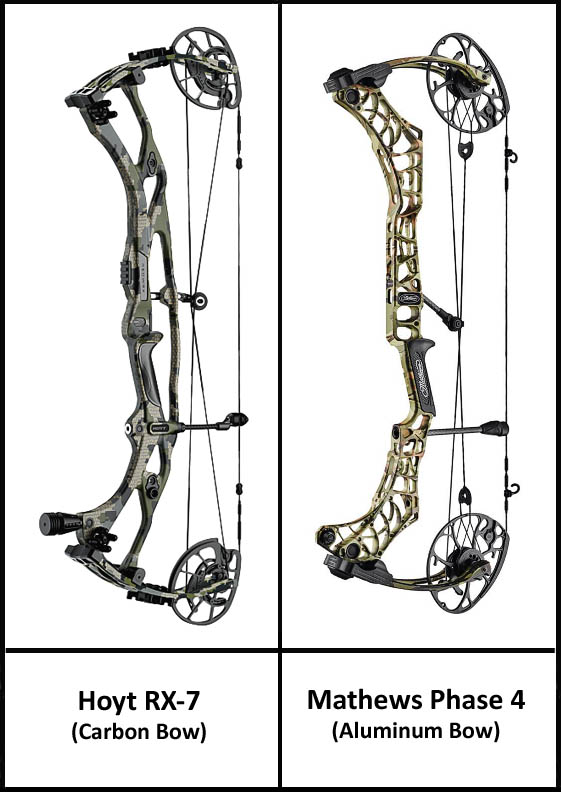
Carbon vs. Aluminum Bows
If you are in the market for a new compound bow, one of the first things to consider is carbon or aluminum. There’s a pretty even split between hunting camps about which is better. In this article we’ll contrast the pros and cons of each bow type.
Let’s first take a look at carbon.
Carbon fiber bows aren’t really all carbon; just the main handle section, or riser, is carbon. The limbs are made of a variety of high-tech materials not relevant to this topic. Carbon fiber is very strong, stable, and lightweight which makes a perfect platform for anything from bikes to bows.
Advantages to Carbon Bows
The greatest advantage to carbon is that it’s lightweight, yet very strong. On average, a carbon bow weighs about a pound less than an aluminum bow. Aluminum is relatively dense and heavy. The only way to make aluminum lighter is by making it thinner, but that also makes it weaker. Aluminum bows aren’t really weak; they’re just not as tough as carbon.
Carbon bows are ideal for backcountry bowhunters who count every ounce. Lugging a heavy aluminum bow laden with arrows into extreme country can be a hindrance. And since carbon bows are stronger, they can stand up to more abuse in the backcountry. Another nice thing about carbon is that you can easily add more stabilizer weight to make it heavier, if you so choose.
Another advantage carbon has over aluminum is that carbon stays warm to the touch. The handle of an aluminum bow can become unbearably cold in freezing conditions. It’s not a big deal if you shoot with gloves on, but wearing thick gloves can be problematic and cause side-to-side torque issues.
Advantages of Aluminum Bows
First off, if you’re on a budget, aluminum might be your only option. Carbon bows run about 30-40 percent more expensive than aluminum bows. This averages around $500 difference. Higher end aluminum models list around $1200 whereas carbon bows hover around $1700. Currently, the most expensive hunting bow costs around $1800, and is made by Hoyt.
There are also more aluminum bows on the market than carbon bows. The whole carbon fiber manufacturing process is very expensive. Some bow manufactures don’t even make carbon bows simply because there’s a high enough demand for their aluminum offerings, and so they don’t need to invest in the expensive carbon technology.
Because aluminum is denser than carbon, aluminum bows tend to have less vibration or “hand shock.” Fortunately excess vibration has been reduced in newer model carbon bows. Still, some hunters prefer a heavier bow. Simply put, a heavier bow is a steadier bow. Heavier bows are also less affected by crosswinds.
If you like aluminum bows but hate the weight, you can always replace the standard accessories (stabilizer, sight, quiver, and arrow rest) with carbon or composite materials. However, you’ll still be limited on how much you can ultimately reduce overall weight.
Pros and Cons Overview:
Carbon PROS
- Lighter than aluminum
- Stronger riser
- Warmer to the touch
Carbon CONS
- More expensive
- More vibration
- Less carbon bow choices
Aluminum PROS
- Less expensive than carbon
- Less bow vibrations
- More bow choices
Aluminum CONS
- Heavier than carbon
- Cold in winter conditions
- Not as strong
Conclusion
There is no right or wrong bow; both carbon and aluminum bows have their pros and cons. What it really boils down to personal preference.
If you prefer a lighter bow, carbon would be a better choice. If you’re on a tight budget, aluminum might be your only option. Maybe you just like the look and style of one bow over another. If you still can’t decide, just head to your local archery shop and see which one shoots and feels best in your hand.

